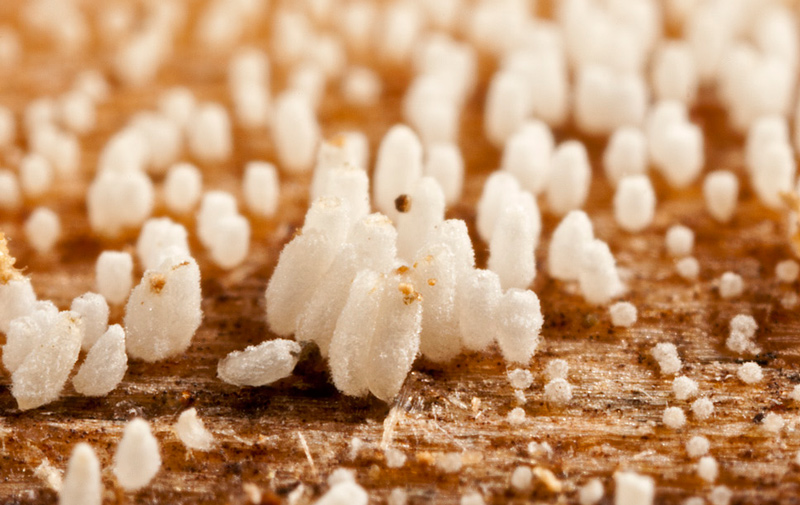Small Wonder
Mycologists nowadays spend too much time writing grant proposals and not enough time lifting up logs. The latter occupation strikes me as so interesting that I can hardly pass a log without wanting to lift it up. And upon lifting up a log, I’ve occasionally found a cyphelloid species called Henningsomyces candidus.
 A word about cyphelloid fungi. Their cup or disc-shaped fruiting bodies suggest that they’re discomycetes, but they’re really basidiomycetes or, in the words of mycologist Ian Gibson, “basidiomycete cup fungi.” DNA researchers sometimes refer to them as “reduced agarics,” and reduced they certainly are — most fruiting bodies are no more than a few millimeters in diameter. Yet as if to compensate for their small size, they usually fruit in swarms.
A word about cyphelloid fungi. Their cup or disc-shaped fruiting bodies suggest that they’re discomycetes, but they’re really basidiomycetes or, in the words of mycologist Ian Gibson, “basidiomycete cup fungi.” DNA researchers sometimes refer to them as “reduced agarics,” and reduced they certainly are — most fruiting bodies are no more than a few millimeters in diameter. Yet as if to compensate for their small size, they usually fruit in swarms.
Henningsomyces candidus is so small (1-2 fruiting bodies per mm) that it might be confused with a generic white crust fungus. But get out your hand lens, and you’ll see an array of tubular fruiting bodies with apical pores that resemble sea squirts gone terrestrial. Or perhaps clusters of miniature macaroni. A friend in New Brunswick was even more specific — she compared the fruiting bodies to ziti. With a microscope, you’ll see that each “ziti” (zitum?) has dichophytic hairs around the margin that resemble branches on a tree. You’ll also see fusiform cystidioles, 2 or 4 sterigmate basidia, and subglobose or slightly elliptical spores. If the spores are more than slightly elliptical, you’ve probably peering at a similar species, the scatologically-named Rectipilus fasciculatus, which — MycoKey to the contrary — is not in synonymy with H. candidus.
In the Eastern U.S., H. candidus can be found under hardwood logs (or under the bark of rotting birch logs) as well as under the occasional softwood log, while in the West it commonly grows on ponderosa pine. I usually find it in the spring or early summer rather than in the fall. There are good Henningsomyces years and bad ones. 2011 happens to be a banner Henningsomyces year: between April and early July, I’ve found specimens in Cambridge (MA), on the summit of Mt. Graylock (western MA), near Duluth (MN), and in several different parts of New Brunswick. So start lifting up logs, for the Henningsomyces mycelium might have exhausted itself this year, and you won’t find any specimens at all next year…
Lawrence Millman is the author of the new guidebook Fascinating Fungi of New England (Kollath & Stensaas), which, in addition to a well-rounded cast of big tasty mushrooms, contains many odd and unusual species like the one he describes above. It is written in a charming, convivial style and very beautifully illustrated. You can order autographed copies of the book, lauded by (among others) Gary Lincoff, by contacting the author at: L.Millman@comcast.net
- Bodensteiner P, Binder M, Moncalvo JM, Agerer R, Hibbett DS. 2004. Phylogenetic relationships of cyphelloid homobasidiomycetes. Mol Phyl Evol 33:501–515. [PDF file]
- Henningsomyces candidus chez MycoQuébec. [would you like to view it in quirky English via Google Translate?]
Thanks to Joe Warfel for kind permission to use his photo, of a specimen that he and the author found while lifting logs atop Mount Greylock, in Massachusetts, during the Berkshire Bioblitz.
Comments Off on Small Wonder

